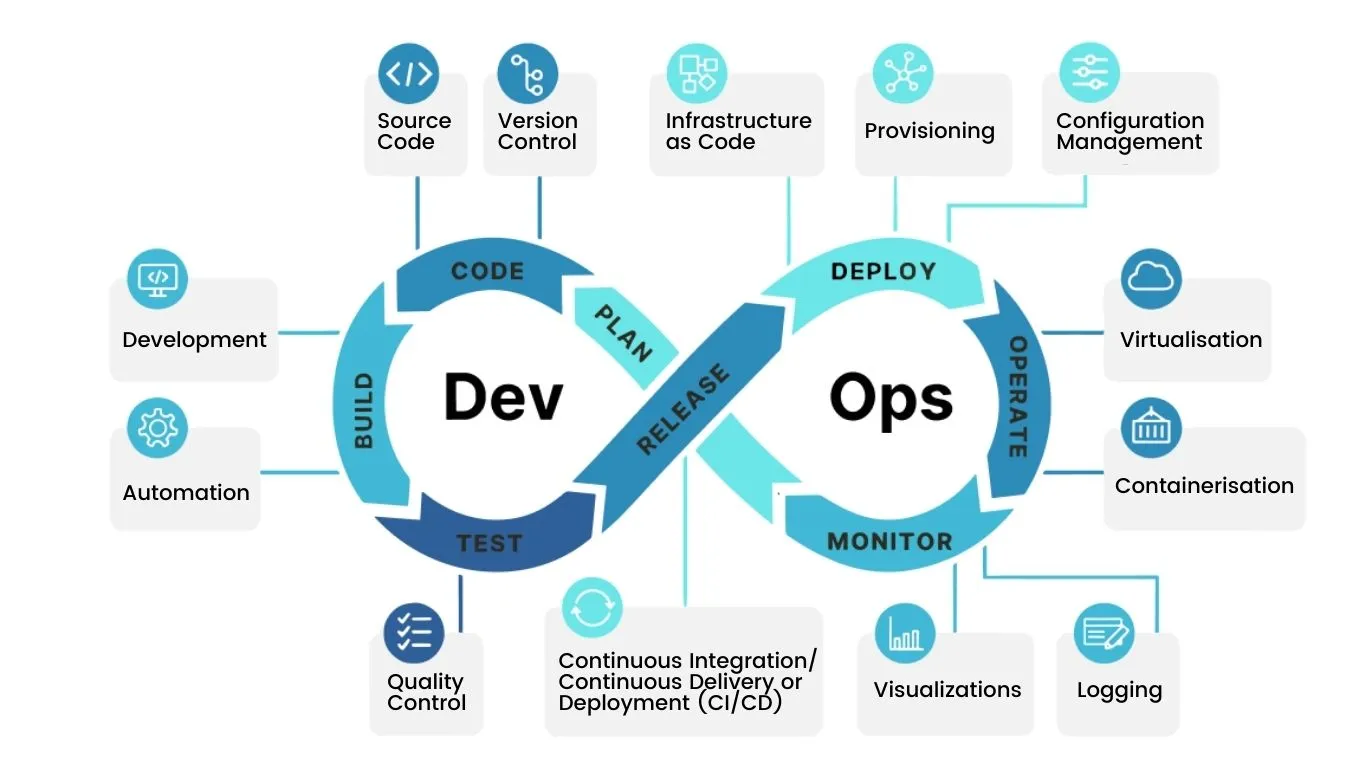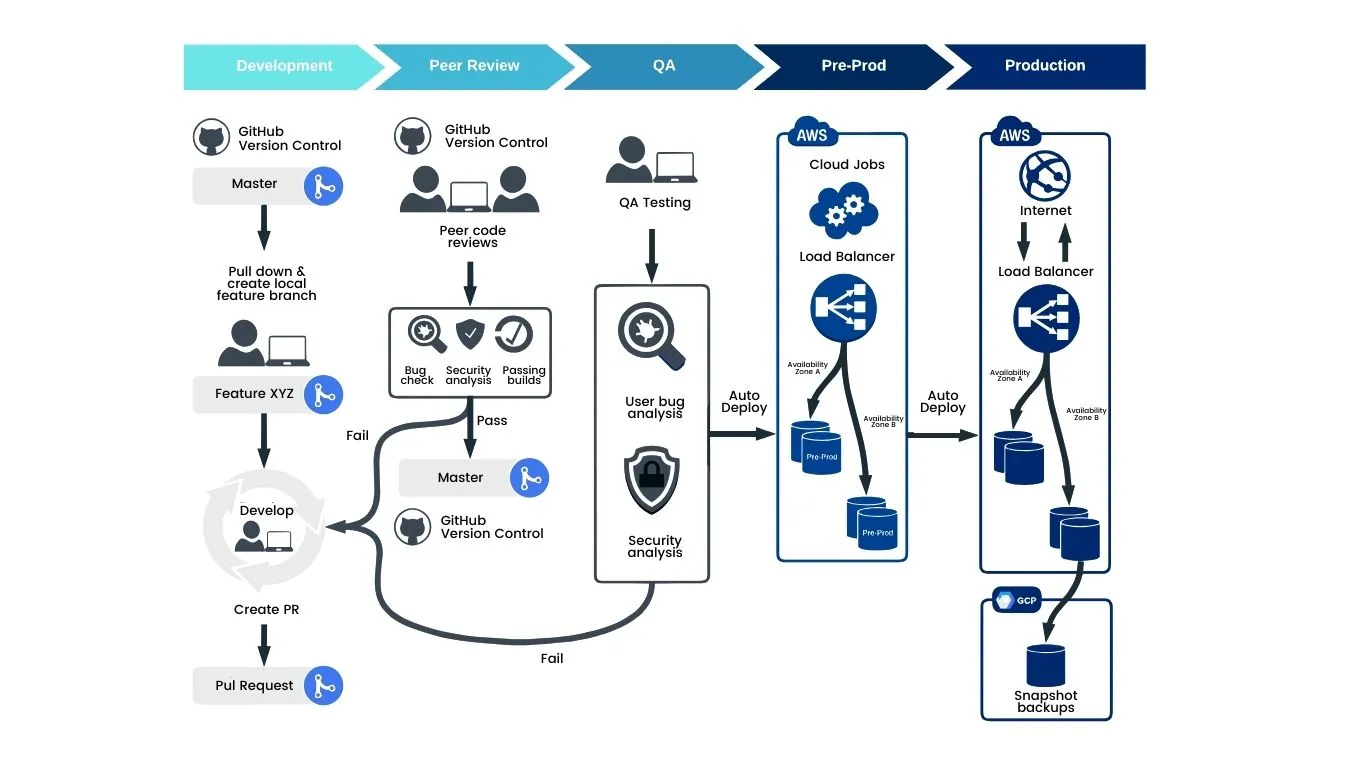DevOps process is a beacon of transformation. DevOps, a portmanteau of "Development" and "Operations," represents more than just a methodology; it's a culture, a mindset, and a set of practices that have redefined how software is built, tested, and delivered. In this comprehensive guide, we will embark on a journey through the intricacies of the DevOps process, exploring its distinct phases, tools, and best practices.
The Essence of DevOps
A study by Forrester found that organizations with a mature DevOps practice achieve 22% higher revenue growth and 20% higher profits than organizations with a less mature DevOps practice. This practice embodies the synergy between development and operations teams, breaking down silos and fostering a collaborative environment. This cultural transformation is underpinned by a well-defined DevOps workflow and a streamlined DevOps pipeline, where code moves seamlessly from development to production. DevOps is the enabler of rapid, iterative development, enabling organizations to respond to market demands with agility and precision.
The DevOps development process represents the linchpin that holds the entire “philosophy” together. A well-structured DevOps process ensures the automated building, testing, and deployment of code, reducing manual intervention, minimizing errors, and enhancing reliability. It empowers teams to deliver software with unmatched speed and quality, driving innovation and gaining a competitive edge. So let’s eat this “elephant” bit by bit.
Delving Into DevOps Principles
DevOps philosophy seeks to bridge the chasm between software development and IT operations. DevOps is not merely a set of practices but a cultural transformation that hinges on several key principles, each bearing immense significance in reshaping the software development landscape.
DevOps Philosophy
Nothing groundbreaking: Development and Operations methodology represents a fundamental shift in how software development and IT operations teams collaborate and function. It advocates the breaking down of silos, fostering a culture of collaboration and shared responsibility. DevOps embodies a relentless pursuit of efficiency, achieved through automation, where manual, error-prone tasks are replaced with repeatable, scriptable processes. It champions the idea of continuous improvement through monitoring and feedback, driving organizations to evolve and innovate at an unprecedented pace.
Key DevOps Principles
1. Collaboration: DevOps emphasizes the need for seamless collaboration between development and operations teams. By breaking down traditional barriers, teams can collectively focus on delivering value to users. The study by specialists at Leiden University revealed that DevOps implementation boosts collaboration by 47% on average.
2. Automation: Automation is the linchpin of DevOps. It involves automating repetitive tasks, such as code builds, testing, and deployment, to enhance efficiency and reduce errors.
3. Continuous Integration: Continuous Integration (CI) ensures that code changes are frequently and automatically integrated into a shared repository. This practice prevents integration issues and promotes code quality. A study by IBM found that organizations that use continuous integration are able to reduce the time it takes to release software by at least 30%.
4. Continuous Delivery/Deployment: Continuous Delivery (CD) and Continuous Deployment (CD) streamline the process of releasing code to production. CD ensures that code is always in a deployable state, while CDeployment automates the release process itself.
5. Monitoring and Feedback: Continuous monitoring of applications and infrastructure provides real-time insights. Feedback loops inform teams about issues and performance bottlenecks, enabling rapid improvements. A study by Gartner found that organizations that collect and act on feedback from users are able to improve the quality of their software by 20%.
Why You Could Do With DevOps Principles
Why? Just because embracing these principles can yield profitable results. At least the following ones.
Accelerated Delivery: DevOps practices enable organizations to bring new features and updates to users at a much faster pace. For example, consider a mobile app development team that adopts DevOps. Before DevOps, they released updates every two months. After implementing DevOps principles, they can now release updates every two weeks. This accelerated delivery allows them to respond quickly to user feedback and changing market demands.
Enhanced Quality: Automation and continuous testing in DevOps lead to improved software quality. Take an e-commerce website as an example. Before DevOps, they often encountered critical bugs in their production releases, leading to customer frustration. With DevOps practices, they implement automated testing, catching and fixing issues early in the development pipeline. As a result, they see a significant reduction in post-release defects, ensuring a smoother shopping experience for customers.
Improved Collaboration: DevOps fosters a culture of collaboration, breaking down silos between development and operations teams. Consider a scenario where a software development team had limited interaction with the operations team. This lack of collaboration led to misconfigurations and delays in deployment. After embracing DevOps principles, they establish cross-functional teams that work closely together. This collaboration streamlines the deployment process, reduces errors, and enhances overall efficiency.
Reduced Costs: Automation in DevOps significantly reduces manual effort, leading to cost savings. Imagine an organization that previously relied on manual server provisioning and configuration. With DevOps automation tools like Ansible or Terraform, they can automate these tasks, reducing the need for dedicated personnel and saving both time and money.
Enhanced Customer Satisfaction: Rapid updates and bug fixes result in improved user experiences and higher customer satisfaction. There is a storified example for this case. Imagine an online streaming service called "StreamStar." StreamStar decided to embrace DevOps principles to enhance its services. The team implemented automation for scaling their infrastructure during peak hours and continuously monitored their servers and network performance. The result? During the next major live event, their platform remained stable, with no buffering issues. Users enjoyed uninterrupted streaming, and the customer support team received commendations instead of complaints.
Preparing for DevOps Adoption
The journey towards DevOps adoption is a profound cultural and operational transformation. Organizations must embark on this path with careful planning, a thorough assessment of readiness, and a commitment to nurturing a DevOps workflow that thrives on collaboration, communication, and shared responsibilities. What are the crucial steps and considerations when preparing for DevOps adoption?
Assessing Organizational Readiness
Firstly, organizations should gauge their readiness for any transformation. We won’t provide a checklist because in software development any situation is authentic, but you can at least evaluate the following facets:
Current Practices: Be honest and appraise existing development and operations practices, including their strengths and weaknesses. In marketing, there is a SWOT analysis. In software development, there isn’t exactly the same tool, but there are many other approaches that help assess the dev environment, models and states used, and system architecture.
Technological Infrastructure: The state of the organization's infrastructure, including the compatibility of existing systems with DevOps automation tools.
Human Resources: The skills and expertise of the workforce and their readiness to embrace new tools and methodologies.
Leadership Commitment: The level of commitment from leadership to support and drive the DevOps initiative.
Cultural Willingness: The organization's culture and its receptiveness to change, collaboration, and shared responsibility.
A study by Puppet and CircleCI, the "State of DevOps Report," found that high-performing organizations prioritize assessing readiness and aligning it with their DevOps efforts. They are 1.5 times more likely to conduct a DevOps assessment compared to lower-performing organizations.
Building a DevOps Culture
DevOps is not just about tools; it's about cultivating a culture of collaboration, communication, and shared responsibilities. To succeed, organizations must:
Encourage Collaboration: Break down silos between development and operations teams, fostering cross-functional collaboration and information sharing. For example, an organization can at least break down all the barriers between C suite and regular developers. If the junior programmer has an idea for product improvement, they must have the ability to discuss it with the Solution Architect or CTO directly.
Enhance Communication: Implement clear and efficient communication channels to ensure that all team members are on the same page. Slack, Signal, other messenger, task tracker that fits the team’s needs — all these things are crucial in building efficient communication.
Shared Responsibilities: Promote the idea that everyone involved in the development process shares responsibility for the product's success, from conception to deployment.
According to the "DevOps Culture Survey" conducted by DevOps Institute, over 60% of organizations cited improved collaboration and communication as key drivers for adopting DevOps practices.
Identifying Potential Challenges and Addressing Them
DevOps adoption can encounter several challenges, including resistance to change, lack of skills, and integration issues. It's essential to anticipate these challenges and devise strategies to address them:
Resistance to Change: Conduct change management initiatives to prepare teams for the cultural shift that accompanies DevOps.
Skills Gap: Invest in training and upskilling to bridge the skills gap among team members.
Tool Integration: Choose a DevOps tools chart that seamlessly integrates with existing systems to minimize disruption.
Already mentioned study revealed that organizations adopting DevOps face challenges related to both organizational culture (46%) and resistance to change (38%). Yet, they also reported that these challenges faded away after successful DevOps implementation.
Building the DevOps Toolchain
Let’s not repeat corny phrases like “building an effective DevOps toolchain is crucial for streamlining the software development and delivery process”. It’s water under the bridge. Yet we should mention that each tool serves a specific purpose at different stages of the development lifecycle, enhancing automation, collaboration, and monitoring. And just for your curiosity — take a look at the pic below. Yep, it’s a little bit obsolete but cloud certification for devs is still essential for DevOps adoption.
Note that as of 2023, Amazon
runs a tight ship of the Cloud Market with a 32% share.
Version Control Systems: Git is the cornerstone of version control, allowing teams to manage and track changes to their codebase efficiently. Teams utilize platforms like GitHub, GitLab, or Bitbucket for code hosting and collaboration. For example, developers use Git to track code changes, collaborate on feature branches, and resolve code conflicts seamlessly.
Continuous Integration (CI) Tools: CI tools automate code integration and testing, ensuring that changes are continuously validated. Jenkins, for instance, automatically builds and tests code with each commit, providing early feedback to developers and preventing integration issues. Any CI tool can be used to automatically build and test code changes whenever they are pushed to a version control system. This can help to identify and fix bugs early on in the development process.
Continuous Deployment/Delivery (CD) Tools: CD tools automate the deployment and delivery of code to production or staging environments. A CD tool can be used to automatically deploy code changes to production whenever they pass all of the tests in the CI pipeline. This can help to reduce the time it takes to release new features and bug fixes to users. Kubernetes orchestrates containerized applications, ensuring scalability and resilience. Docker simplifies application packaging and ensures consistency across environments. Together, they enable rapid, reliable deployments.
Infrastructure as Code (IaC) Tools: IaC tools automate the provisioning and configuration of infrastructure. Terraform enables infrastructure as code by defining resources in a declarative format. Ansible automates configuration management and application deployment. For example, Terraform can provision cloud servers, databases, and networks, while Ansible configures them according to defined specifications.
Monitoring and Logging Tools: Monitoring tools provide real-time insights into the performance and health of applications and infrastructure. Prometheus collects metrics and triggers alerts for anomalies. The ELK Stack (Elasticsearch, Logstash, Kibana) aggregates, processes, and visualizes logs and data. For instance, Prometheus can monitor server CPU usage and raise an alert if it exceeds a threshold, while the ELK Stack can help identify and troubleshoot application errors through logs.
Select strategically and integrate these tools smoothly into the DevOps toolchain, and your organization will be able to automate repetitive tasks, enhance collaboration, and gain deep insights into its software development and deployment processes. This toolchain not only accelerates delivery but also improves overall software quality and reliability.
The DevOps Development Lifecycle: Embracing the 4 C's of DevOps Processes
Overall success hinges on embracing a well-structured and continuous development lifecycle. We can divide it into 4 parts, 4 C’s: Continuous Planning, Continuous Integration (CI), Continuous Deployment/Delivery (CD), and Continuous Monitoring and Feedback. Each of these phases plays a pivotal role in ensuring seamless collaboration, automation, and the rapid delivery of high-quality software.
Continuous Planning
Collaboration between development and operations teams is the bedrock of Continuous Planning. For example, when a financial services organization planned to enhance its online banking system, developers and operations teams collaborated closely to define objectives. They held joint meetings to align on user stories, features, and backlog management. This collaboration ensured that the development roadmap aligned with operational requirements and constraints. User stories, features, and backlog management help teams prioritize tasks. An e-commerce platform used user stories to outline customer-facing features. Their backlog management included tracking user stories and assigning priorities. This facilitated clear communication between teams, ensuring that development work directly contributed to achieving business goals.
Continuous Integration (CI)
Code versioning and integration are fundamental in CI. A software development team used Git for version control. Every code change triggered an automatic integration process. This practice prevented code conflicts and integration issues, allowing developers to focus on writing code rather than resolving merge conflicts. Automated testing, including unit, integration, and regression testing, is critical in CI. A SaaS provider employed automated testing scripts to ensure code quality. Unit tests checked individual components, integration tests verified interactions between modules, and regression tests ensured that new code changes did not break existing functionality. Building and validating artifacts automatically streamlines the CI pipeline. An online gaming company automated artifact generation. When developers pushed code changes, the CI pipeline automatically built and validated artifacts. This reduced manual intervention, accelerated the development process, and improved code reliability.
Continuous Deployment/Delivery (CD)
Automated deployment pipelines are central to CD. A cloud services provider adopted tools like Jenkins and Kubernetes for CD automation. When the code passes CI tests, the CD pipeline automatically deploys it to production or staging environments. This minimizes deployment errors and ensures a consistent deployment process.
The full picture of the software delivery process
Deployment strategies such as blue-green, canary, and rolling updates enhance CD. A large e-commerce platform employed blue-green deployments to reduce downtime during releases. The new version was deployed alongside the old one, and traffic was switched seamlessly. This approach enabled quick rollback if issues arose. Monitoring and rollback procedures are vital components of CD. An airline booking system incorporated automated monitoring and rollback procedures. If a new release caused an increase in error rates or performance issues, the system automatically rolled back to the previous version, minimizing customer impact.
Continuous Monitoring and Feedback
Implementing monitoring and logging is essential for both applications and infrastructure. A social media platform utilized Prometheus and the ELK Stack for monitoring and logging. They collected data on server performance, application errors, and user interactions. This allowed them to detect issues proactively and troubleshoot effectively. Collecting and analyzing performance metrics aids in assessing system health. An e-learning platform used Grafana to visualize performance metrics. They tracked server response times, database query latency, and user engagement. This data guided optimization efforts and ensured a smooth user experience.
Feedback loops for continuous improvement close the DevOps lifecycle. A healthcare software provider established feedback loops through post-release surveys and incident reports. User feedback and incident analysis drove iterative improvements, enhancing the software's reliability and user satisfaction. In the Web space, you definitely can find different explanations and “schemes” of DevOps processes. With 6 C’s or even 7 C’s, for example. But these 4 C's of DevOps Processes are the basis for creating a virtuous cycle that leads to continuous improvement, faster delivery, and higher software quality.
Best Practices for Effective DevOps Development
Effective DevOps development can be boosted by a set of best practices that not only streamline the software delivery process but also foster a culture of continuous improvement and innovation. These practices are not just technical; they encompass cultural and organizational aspects, driving success in the DevOps journey.
1. Keep automation at the forefront: Automation lies at the core of DevOps. Embrace tools like Jenkins for CI/CD, Ansible for configuration management, and Terraform for infrastructure provisioning. Automation reduces manual errors, accelerates delivery, and ensures consistency. According to the 2020 State of DevOps Report, high-performing teams are 24 times more likely to fully automate their configuration management than low performers.
2. Establish clear communication channels: Effective communication is the lifeblood of DevOps. Use collaboration platforms like Slack or Microsoft Teams for real-time interaction. Foster open and transparent communication between development, operations, and other stakeholders. This practice ensures that everyone is aligned with project goals and aware of any changes or issues. The DevOps Institute's 2021 DevOps Upskilling report emphasizes that communication skills are among the top skills needed for DevOps success.
3. Regularly review and optimize the DevOps process: Continuous improvement is a fundamental DevOps principle. Conduct regular retrospectives to identify bottlenecks and areas for enhancement. Use metrics and feedback to pinpoint areas of inefficiency. For instance, Netflix conducts "Chaos Engineering" exercises to proactively identify weaknesses in its systems. Such practices lead to resilience and reliability.
4. Cross-functional collaboration and skill-sharing: Break down silos and promote cross-functional collaboration. Encourage developers to understand operations, and vice versa. Create opportunities for skill-sharing and training. The mentioned report from the DevOps Institute also highlights the importance of fostering a culture of learning and sharing knowledge.
For instance, at Amazon, teams are responsible for both development and operations, promoting a deep understanding of the entire software lifecycle. This approach has played a pivotal role in the company's ability to innovate and scale rapidly.
To sum it up
DevOps stands as a beacon of innovation and efficiency, reshaping how software is developed, delivered, and maintained. The journey towards a streamlined DevOps development process is not just a technical endeavor; it's a cultural shift that empowers organizations to thrive in a dynamic landscape.
As you embark on your DevOps journey, remember that success requires a balance of technical excellence and cultural transformation. It's about embracing automation, fostering clear communication, and continuously optimizing processes. DevOps is not a destination but a path towards excellence.
Just embrace that regarding DevOps implementation, the possibilities are boundless, and the future of software delivery is brighter than ever.






